#Islamic Shrines in Pakistan
Explore tagged Tumblr posts
Text
#Women in Islam#Islamic Legacy#Bibi Pak Daman#Female Role Models in Islam#Women’s Character in Islamic History#Islamic Spirituality#Sufi Saints#Islamic Heritage#Women’s Empowerment in Islam#Pakistani Religious Sites#Historical Women in Islam#Role of Women in Islamic Society#Islamic Shrines in Pakistan#Women’s Legacy in Islamic Culture#Religious Tourism in Pakistan
0 notes
Text

#tomb#mausoleum#Sufi shrine#Shrine of Baba Hazrat Taj ud Din Sarwar Chisti Shaheed#Islam#rose petals#Chistian#Bahawalnagar District#Punjab#Pakistan
3 notes
·
View notes
Text
781th Urs Hazrat Baba Farid (RA): Commemorating the Spiritual Legacy of the Sufi Saint in Pakpattan, Pakistan
The 781th Urs of Hazrat Baba Fariduddin Masood Ganj Shakar (RA) will be observed from Monday, 14th July 2023, to Monday, 29th July 2023, at the Shrine of Baba Farid (RA) in Pakpattan, Punjab, Pakistan. This sacred event commemorates the 12th-century Sufi saint of the Chishti Order, who was the successor of Hazrat Khawaja Qutbuddin Bakhtiar Kaki (RA). Hazrat Baba Farid (RA), also known as Baba…
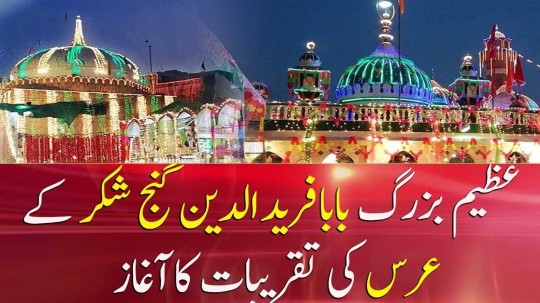
View On WordPress
#781th#Annual Celebration#Bahishti Darwaza#Chishti Order#Divine Love#ganjshakar#hazrat baba fareed#hazrat baba fareed ganj shakar#Hazrat Khawaja Qutbuddin Bakhtiar Kaki#hazratbabafareed#hazratbabafarid#Inner Purity#Interfaith Gathering#Ishq-e-Ilahi (Divine Love)#Islamic Spirituality#Pakistan#Pakpattan#Qawwali#Serenity and Compassion#Shrine of Baba Farid#Spiritual Blessings#Spiritual Legacy#Sufi Poetry#Sufi Saint#Unity and Tolerance#Urs of Hazrat Baba Farid
0 notes
Note
hey sal what is wahhabism and how does it differ from the talibans?
Wahhabism is an ultra-orthodox and traditionalist interpretation of Sunni Islam that was initially introduced by the likes of Muhammad ibn abdul Wahab (son of Abdul Wahab). This movement was founded during backed be the house of Saud after ibn Abdul Wahab formed a pact with Muhammad bin Saud, providing the house of Saud with military backing, so that they could oust the Ottoman Turks. While the Saudi states failed during several occassions ever since, the British backed the House of Saud during the first world war for their oil and their mutual opposition to the Turks, leading to the creation of Modern Saudi Arabia with Wahhabism as its official religions.
Wahhabism follows a traditional interpretation of Sunni Islam and rejects the idea of metaphorical and rationalist traditional exegesis, this contrasts with earlier Islamic schools of theology, like the Asherites and Maturidis. Wahhabism is a reactionary/revivalist movement that sought to purify Islam from heresies. This would involve strict monotheistic interpretations, such as iconoclams, rejection of intercession, destruction of shrines, opposition to the idea of religious schools of thought (Madhabs) and the strict abandonment of religious innovations (Bid'ah). Due to this strict form of Sunni Islam, Shi'a Muslims and other Muslim minorities were particularly at odds with their interpretation and massacred as a result. Due to their opposition to Taqlid, the idea that one should conform to the teachings of past juridical opinions, Wahhabists emphasised the concept of Ijtihad, to derive Islamic laws through independent reasoning.
The Talibans are a movement that adhered to the Hanafi school of thought knowns as Deobandi, and ultimately follow the idea of Madhabs and Taqlid. They were originally part of the Mujahideen, a group of fighters during the Soviet intervention in Afghanistan and were funded by the US. Due to a power struggle within that group, a faction of the Mujahideen became known as the Taliban and imposed an Islamic theocracy. With that said, the Talibans and Wahhabis are in stark contrast with each other due to their interpretation of Islamic law and theology. Due to deriving their laws from the classic scholar, Abu Hanif, Wahhabists often condemn the Talibans for adhering to Taqlid, whereas the Talibans reject the idea of Ijtihad, condemning the Wahhabist for not adhering to one of the four Sunni Islamic schools of thought. The Talibans are known to adhere to Pasthuwali, which is a code of conduct generally practiced in the Pashtun belt (Eastern Afghanistan & Western Pakistan) known for its rather brutal rules.
135 notes
·
View notes
Text
Midway through Jamil Jan Kochai’s collection The Haunting of Hajji Hotak and Other Stories, which maps generations of Afghan and Afghan American lives against over a century of entwined wars, sits what appears to be a résumé. Entitled “Occupational Hazards,” it meticulously records the everyday labors of an Afghan man: [...] his “[d]uties included: leading sheep to the pastures”; from 1977–79, “gathering old English rifles” left over from the last war while being recruited into a new war; in 1980–81, “burying the tattered remnants of neighbors and friends and women and children and babies and cousins and nieces and nephews and a beloved half-sister”; [...] becoming a refugee day-laborer in Peshawar, Pakistan; in 1984, becoming a refugee in Alabama, where he worked on an assembly line with other Asian migrants whom the white factory owner used to push out the local Black workforce; and so on. Dozens of events, from the traumatic to the mundane, are cataloged one by one in prose that is at once emotionless and overwhelming. [...] Kochai interviewed his father for the résumé’s occupational trajectory [...]. An Afghan shepherd [...] is displaced by imperial wars and then, in the heart of empire, is conscripted into racialized domestic economies [...]. [M]ethodically translating lived violence via a résumé, a bureaucratic form that quantifies labor in its most banal functionality, paradoxically realizes the spectacular breadth of war and how it organizes life’s possibilities. [...]
---
In this collection, war is past, present, and plural. In Afghanistan, Kochai recounts the lives of Logaris and Kabulis, against the backdrop of the US occupation, still dealing with the detritus of previous wars - British, Soviet, and civil - including their shrines, mines, and memories. In the United States, Afghan Californians experience the diasporic conditions of war -- state neglect of refugees combined with targeted surveillance -- amid the coming-of-age of a second generation that must confront inherited traumas while struggling to build political solidarities with other displaced youth.
These 12 stories explore the reverberations between historical and psychic realities, invoking a ghostly practice of reading. Characters, living and dead, recur across the stories [...]. Wars echo one another [...]. Scenes and states mirror each other, with one story depicting Afghan bureaucracies that disavow military and police violence while another depicts US bureaucracies that deny social services to unemployed refugees. History itself is layered and unresolved [...]. Kochai, who was born in a refugee camp in Peshawar, writes from the position of the Afghan diaspora [...]. In August 2021, the US relegated Afghanistan to the past, declaring the “longest American war” over. Over for whom? one should ask. [...] War, in other words, is not an event but a structure. [...]
---
In Kochai’s collection, war is not the story; rather, war arranges the scenes and life possibilities [...]. Kochai carefully puts war itself, and the warmakers, in the narrative background [...].
This is a historically incisive narrative design for representing Afghanistan. Kochai challenges centuries of Western colonial discourses, from Rudyard Kipling to Rambo, that conflate Afghanistan with violence while erasing the international production of that violence as well as the social and conceptual worlds of Afghans themselves. Instead, this collection moves the reader across Afghans’ transcontinental, intergenerational, and multispirited social worlds -- including through stories of migrations and returns, homes populated by the living and the martyred, language that enmeshes Dari, Pashto, and Northern California slang, as well as the occasional fantastical creature [...].
---
Like Kochai’s debut novel 99 Nights in Logar (2019), this collection merges realism and the fantastic, oral and academic histories, Afghan folklore and Islamic texts, giving his fiction a dynamic relation to history. Each story is an experiment, and many of them are replete with surreal or magical elements [...].
As in Ahmed Saadawi’s 2013 novel Frankenstein in Baghdad, a nightmarish sensorium collides with a postcolonial body politics [...].
In a recent interview, Kochai said that writing about his family’s experiences of war has compelled him to explore “realms of the surreal or magical realism […] because the incidents themselves seem so unreal […]. [I]t takes years and decades to even come to terms with what had actually happened to them before their eyes.” He points not to a documentary dilemma but to an epistemological one. While some scholars have argued that fantastic genres like magical realism are often conflated with exoticized imaginaries of the Global South, others have defended the form’s critical possibilities for rendering complex realities and multiple modes of interpretation. Literary metaphors, whether magical or otherwise, are always imprecise; as Afghan poet Aria Aber puts it, “you flee into metaphor but you return / with another moth / flapping inside your throat.” [...]
Kochai does not “escape” into the surreal or magical as fictions but as other ways of reckoning with war’s pasts ongoing in the present.
---
All text above by: Najwa Mayer. “War Is a Structure: On Jamil Jan Kochai’s “The Haunting of Hajji Hotak and Other Stories.”“ LA Review of Books (Online). 20 December 2022. [Bold emphasis and some paragraph breaks/contractions added by me. Presented here for commentary, teaching, criticism.]
#haunting#tidalectics#carceral geography#intimacies of four continents#multispecies#gothic#geographic imaginaries#frankenstein in baghdad#afghan#carceral archipelago
95 notes
·
View notes
Text
15/11/24
Went to the Ravi river with my gf and two of her friends. We were late because had to get breakfast and got lost in a very narrow dirt road that ended up at a dead end. Gf gifted me a sweater of hers that luckily looked amazing on me.
We parked near an unnamed shrine hidden behind some thick shrubbery. Her colleagues were really nice and I never felt like a tag along. We were warned about the presence of robbers beyond the river bank which gave me an opportunity to flex how I am friends with certain families connected with the underworld that seems to mar all the rivers of our Punjab. Spotted hatched snake eggs and alot of mushrooms. The fog added to the mystique of the experience and a member of our party who (apparently) had not been out much was genuinely on the verge of attaining moksha. Got scolded for offering my jacket to gf's friend when her fingers were swelling from the cold.



Met a cowherd who offered to protect us with his life and his friend who proudly told us how he had only ever loved one woman and had never remarried after God took her. When told that we were feeling refreshed out here in the open by the river side the cowherd said ,"We came from this earth and when we die we shall have to return to it". It is an extremely disorienting experience to hear a Punjabi pastoralist in the Islamic Republic of Pakistan echo the Quran when it says, "We have created you from the earth, into it We shall return you and from it We shall bring you back to life once again." [Quran 20:55] Which itself parallels the teachings expounded by the so called "Jahwist" whose words are preserved in Genesis saying "By the sweat of your brow will you have food to eat until you return to the ground from which you were made. For you were made from dust, and to dust you will return." [Gen 3:19]
A tapestry of history strung together by God like pearls in a necklace.
The guy in the group kept telling my gf to stop using colonial concepts like "occupation" , "property" and "earning money" we would only later realise it was his dead pan attempt at humour. He also told us straight faced that if any of them died he would not hold himself responsible which made me glad that I joined.
We got spooked by some people from the opposite bank who were offering refreshments and by 2 men on a bike who were driving around in reference to the warnings given to us. Saw a shivering puppy and tried to comfort it as best as I could, lamented the fact that I had only packed crisps.
Kept reminiscing on the fact that the banks of the river Ravi is where King Sudas faced off the tribal coalition in the Battle of the Dasarajya. The First event in Indian History. A battle insignificant in the scale of things of probably one of the single most consequential battles in our ancient history. A war between a disciple and guru that laid the foundations of vedic society, the kuru kingdom and the lens through which all subsequent indic dynasties would look at themselves through.
This is the same river where my ancestors would have stood, bronze sword in hand, blood coursing through their veins, their lungs hurting as they could taste the blood in their mouth. Staring their enemy in the eyes as they frantically grabbed at one another, stabbing, skewering and slashing. Being stabbed, skewered and slashed. Bodies crushed under chariot wheels, mothers losing their sons, wives losing husband, terrifying beasts of war charging as Indra was invoked with every breath. Alhamdulillah. I have learned to own my ancestor's hindu jahiliyyah* as my own.

Afterwards we all went to have lunch at a "dhaaba". Told them about how me and gf met over good reads and then email before I finally got her number. Had a very refreshing conversation which oscillated between alpha males, astrology, Dune, Sociology, LOTR, Harry Potter and Islamic Waqf Law. Would love to accompany them again.
Brought gf home and we had her shoes cleaned, she attended online classes and I prepared for my send up exams. Afterwards dropped her off at her university and I wanted to stay up to study but fell asleep.
*Arabic word for The Ignorance traditionally used for pre Islamic Arabia but can be used to refer to the pre Islamic past of any entity.
#diary#ravi#med student#university#ethnography#anthropology#sociology#study blog#hindublr#muslimblr#islam#hindu#student#studyblr#dune#harry potter#lotr#bible#bible study#quran#book of genesis
4 notes
·
View notes
Text
Despite attempts by President Vladimir Putin and Russia's state-controlled media to pin the blame for Friday's deadly Moscow theatre attack on Ukraine, more details are emerging about the jihadist group IS-K that has claimed it was behind it.
Who or what is IS-K?
IS-K is an abbreviation of Islamic State-Khorasan - a regional affiliate of the Islamic State group, which has been proscribed as a terror organisation by governments across the world.
It is focused on Afghanistan, Iran and Pakistan and into Central Asia.
The group has given itself the name Khorasan as that was part of an historic Islamic caliphate spanning that region.
IS-K has been around for nine years but in recent months it has emerged as the most dangerous branch of the Islamic State group, with a long reach and a reputation for extreme brutality and cruelty.
Along with what is left of the group's wider leadership in Syria and Iraq, IS-K aspires to a pan-national Islamic caliphate ruled through an ultra-strict interpretation of Sharia, Islamic law.
In Afghanistan it is waging a sporadic but still deadly insurgency against the country's rulers, the Taliban, who it opposes on ideological grounds.
Has IS-K carried out attacks before?
It targeted the chaotic evacuation from Kabul airport in 2021 with a suicide bomb, killing 170 Afghans and 13 US servicemen.
The following year it targeted the Russian embassy in Kabul, killing at least six people and injuring others.
The group has carried out indiscriminate attacks on a maternity ward, bus stations and policemen.
In January this year, IS-K carried out a double bombing of a shrine in Kerman, Iran, killing nearly 100 Iranians.
In Russia it has carried out numerous small-scale attacks, the most recent being in 2020 - and already this year the FSB, Russia's internal security service, says it has stopped several terror plots.
Who were the Moscow attackers?
According to Russian state media the four men captured and charged are all Tajiks from the Central Asian republic of Tajikistan, which used to be part of the Soviet Union.
It is obvious from their battered and bruised appearance in court that they have been especially harshly interrogated to the point of torture.
The problem with that is according to international norms, their confessions will be worthless - people will say anything to make the pain stop, including confessing to a narrative that is simply untrue.
Reports have emerged that one of the men was seen carrying out surveillance of the venue in early March, around the time the US warned Russia there was an imminent threat of a terrorist attack on a public space - a warning the Kremlin dismissed at the time as "propaganda".
Another report says at least two of the attackers arrived in Russia recently, implying that this was a "hit team" sent by IS-K, rather than a sleeper cell of residents.
Why did they target Russia?
There are several reasons.
IS-K consider most of the world to be their enemies. Russia is high up on their list, along with the US, Europe, Israel, Jews, Christians, Shia Muslims, the Taliban and all rulers of Muslim-majority states, who they consider to be "apostates".
Islamic State's hostility to Russia goes back to the Chechen wars in the 1990s and early 2000s, when Moscow's forces devastated the Chechen capital Grozny.
More recently, Russia entered the Syrian civil war on the side of its ally, President Bashar al-Assad, and the Russian air force has carried out countless bombings of rebel and civilian positions, killing large numbers of Islamic State group and Al-Qaeda-linked fighters.
In Afghanistan, IS-K view Russia as being an ally of the Taliban, which is why they attacked the Russian embassy in Kabul in 2022.
They also bear a grudge for the 10 years of brutal Soviet occupation of that country from 1979-89.
Then there is the situation inside Russia itself.
Russia is viewed by IS-K as very much a Christian country and their video posted after the Moscow attack talks about killing Christians.
Tajik and other Central Asian migrant workers are sometimes subject to a degree of harassment and suspicion by the FSB as it seeks to head off terrorist attacks.
Finally, Russia - a nation currently distracted by its full-scale war with its neighbour Ukraine - may simply have been a convenient target of opportunity for IS-K, a place where weapons were available and their enemy's guard was down.
What do we still not know about the Moscow attack?
There remain a number of unanswered questions about this whole episode.
For example, why were the attackers able to wander at will for nearly an hour around the Crocus Hall with absolutely no apparent sense of urgency?
In a country where the police and special services, notably the FSB, are omnipresent, these gunmen behaved as if they knew they were not going to be interrupted by a police SWAT team.
Then there are the weapons - not just handguns but powerful, modern automatic assault rifles. How were they able to acquire these and smuggle them undetected into the venue?
Their swift capture is also surprising.
Unlike many jihadist gunmen on a raid like this, these men were not wearing suicide vests or belts, in the manner of those who prefer death to capture.
And yet, it did not take long for the Russian authorities - the same Russian authorities who failed to stop the worst terror plot in 20 years unfolding beneath their noses - to round up the suspects and put them on trial.
All this is prompting some analysts to speculate about some sort of so-called "inside job" by the Kremlin, or a "false flag operation" to garner popular support for the war on Ukraine.
However, there is no hard evidence to support that theory and US intelligence has confirmed that in their view, it was Islamic State behind this hideous attack.
5 notes
·
View notes
Text
Hijra (South Asia)
Hijra (Arabic: ہیجڑا) is a south asian subcultural identity for transgender women, transvestites (MTF), androgynous male, intersex & non-binary folks. Many Hijras lives in well-organized communities, led by a guru (leader) in Bangladesh, Pakistan, India & some parts of Nepal. Traditionally, hijras are recognized as a “distinct gender” which is different from the normative male & female genders. Most of them are assigned “male” at birth, while a small number of hijras are born intersex and later develop a feminine gender identity or gender ambiguity. Hijras usually present themselves in feminine attire, use feminine names & pronouns for themselves. Some hijras may present themselves in masculine outfits, may use masculine names or vice-versa. Both Izak & Hijragaan are equivalents of the term “Hijra” in Afghanistan. Afghani vernacular term Izak refers to eunuch or people of ambiguous gender/sex. Izak is also used as a slurr against LGBTQI+ community.
Hijra Culture
Hijras has their own traditions, rituals, cults, language & festivities. Hijras typically earn a living through various means, including participating in toli–badhai (ritual blessings), collecting alms, begging, prostitution, dancing & singing at different occasions. These activities serve as common sources of income within the hijra community. Most of the Hijra communities follows a kinship known as guru-chela or guru-shishyaa. This kinship is based on hierarchal relationships of discipleship among hijras, organizing themselves into different dera/gharanas (house). These dera/gharanas serve as social units, provide a sense of belonging and support to gender-diverse folks. Many hijras try to maintain matrilineal relationships within their communities; these relationships include guru ma or ma (mother), daughter, maasi or mausi (aunty), sister, niece, nani or naniguru (grandmother). In hijra community, gurus are revered as mother, parent, guardian & sometimes brother. Chelas are revered as son or daughter of guru. In hijra community, individuals can become members through an ritual ceremony or reet which is very much common within Hijra community. Many transgendered hijras & kothis do castration, emasculation before joining the community. However, community membership is not solely dependent on genital mutilation.
The governing bodies within the hijra/kinner community play a central role in maintaining their cultural practices and traditions. These governing bodies hold influential positions on decision-making and community affairs within communities. They contribute to the overall structure and organization of the hijra/kinner/third gender communities.
The spiritual status of hijras is publicly acknowledged & accepted as a part of their gender identity, entitling them to attain a spiritual level referred to as “others” non-hijras. Prior to arrival of Islam in South Asia, kinners (hindu hijra folks) were elevated to the status of demi-god in Indian subcontinent. They were believed to possess supernatural powers that could bestow fertility and good luck upon those who sought kinner's blessings. Upon their conversion to Islam, kinners adopted the label “hijra” which means spiritual migration, transformation, transcend, liminality. Hijras became great devotees of Sufi saints, such as Khwaja Gharib Nawaz, Lal Shahbaz Qalaander, Baba Bulleh Shah. Most of the hijra folks incorporated their Hindu beliefs into their practice of Islam after their conversion. They visits Sufi shrines, temples, and mosques, as well as participate in pilgrimages. Muslim hijras also maintain a belief in the Goddess Bahuchara Maa. Bahuchara Maa is patron of hijra, kinner, transgender woman, eunuch, transvestite, kothi communities. She is also known as Mai Nandi in Pakistan.
Kothi
The word Kothi is common across India & Bangladesh. Other local equivalents of Kothi are Durani (Kolkata), Meti (Nepal), Zenana/Zanana (Pakistan). While Kothis are often distinguished from Hijras, they often dress as women and act in a feminine manner in public spaces, even using feminine language to refer to themselves and each-other. Sometimes the term Kothi is regarded as person who play passive or submissive role in homosexual relationships. In India, the term Kothi refers to effeminate homosexuals & transvestite homosexuals who take feminine role in homosexual relationship with Panthi (a south asian term for masculine gay/bisexual/straight man, who dates hijras & kothis). Majority of kothis don't live in intentional communities that hijras usually lives in. Some argued that term “Kothi” is an all-encompassing term for homosexual bottoms, effeminate males, trans-feminines, transvestites, trans woman, who do not conform to societal, normative gender roles. So the term Kothi would include the identity of Hijra, among others.
Religious Practices
Many hijra communities practice a form of syncretism that draws on multiple religions, including islam, hinduism, buddhism, sikhism, etc. Both Indian hindu hijras/kinners and muslim hijras are devotee of Goddess Bahuchara Maa. Majority of gurus in hijra community are muslim in Indian subcontinent. Annually they pay homage to Hazrat Khawaja Gharib Nawaz in Ajmer Sharif.According to Gayatri Reddy, Indian muslim hijras do not practice Islam differently from other muslims. Their religious syncretism doesn't make them any less muslim. Reddy also documents an example of how this syncretism manifests: In Hyderabad of India a group of muslim converts were circumcised, something seen as the quintessential marker of Muslim identity.
Guru-chela system is very similar to Pir-Mureed discipleship of Sufism. In Sufi traditions, a Pir/Guru (spiritual guider) takes on disciples known as Mureeds, forming a deep and spiritual relationship. Some believes that south asian hijras adopted this system of mentorship & spiritual guidance within their own community.
In Pakistan, most hijras do not practice religious syncretism. But they have great tolerance & compassion for other religions. Pakistani hijras are more connected with sufi cultures & Mughal cultures. Some prefers the term Khawaja Sara for themselves instead of Hijra, Khusra. They pay homage to sufi dargahs, pray at mosque or dargah (in male outfit). Hijras also perform Islamic Hajj & Umrah in Mecca, until 2017 when saudi authorities ban religious pilgrimage for transgender & third gender folks.
Hijra Farsi Language
Hijra Farsi/Farsi Kalaam is a secret code language of hijra, khwaja sara, & zennana communities. It is also spoken among non-hijra LGBTQ+ members. Hijra Farsi was originated during the Mughal Era. Hijra Farsi is widely spoken among muslim hijras, khwajasaras & zennanas. Hindu hijras/kinner speaks Gupti language. known as Hijra Farsi, Farsi Kalaam. Some parts of India & in Bangladesh, it is known as Ulti Bhasha.
History
Hijra identity & culture are documented to have evolved during the Delhi Sultanate (1226-1526) and Mughal Empire (1526-1707), where they held positions as guardian of royal harems, court officials, entertainers, servant for elite households, manual laborers, political advisors, etc. They had been guardians of many sufi shrines in medieval era.
Since 19th century, hijras were targeted by British colonial authorities who sought to eradicate them, criminalised them under Section 377 (1860) & Criminal Tribe Act (1870). This encouraged anti-hijra sentiments throughout the Indian subcontinent, the legacies of which continued in later days. As a result, people started to viewing Hijras differently. Beginning in the 1850s with the British Raj, colonial authorities deployed various strategies to eradicate hijras, whom they saw as "a breach of public decency." The British viewed hijras as incapable of "moral transformation" & assimilation and therefore subjected them to eliminatory policies. In 1860, hijras became subjected to Section 377 of the Indian Penal Code which allowed British authorities to prosecute hijras for their sexuality. Even though they were already criminalized under the Section 377, authorities of the North-Western Provinces (NWP) sought to enact a 'Special law' against hijras in 1861.
By 1870, no high-ranking British officials argued against the implementation of special legislation to address the 'hijra problem,' thus solidifying a violent anti-hijra campaign all across the Indian subcontinent. Anti-hijra laws were enacted; whereas a law outlawing castration (a central part of the hijra community, although not required for community membership), crossdressing, community gathering, ritual practices. Hijras were included in the Criminal Tribes Act (1871) and labelled a "criminal tribe", now subjected to compulsory registration, strict monitoring, and stigmatization. Because of economic costs, which were the main impetus behind British colonialism, Hijras and other so-called "criminal tribes" were unable to be collectively sequestered from colonial society.
Furthermore, Child Removal Projects, which had already begun elsewhere in the British Empire, like Colonial Australia with the forced removal of aboriginal children for assimilation into white settler society, were brought to India for all 'criminal tribes' officially in 1911. Child removal was already in de-facto practice against hijras since the passage of the Criminal Tribes Act (1871) to initiate the extermination of hijra communities by preventing initiation, since the dominant colonial narrative was that all trans & intersex children were "kidnapped and enslaved". Researcher Jessica Hinchy notes that the elimination oriented tactics carried out toward hijras during the colonial era were comparable to what Patrick Wolfe called the 'logic of elimination' in British settler colonies, such as the USA and Australia, as well as the anti-joya campaigns executed by Spanish colonial authorities against gender-diverse people centuries earlier in the establishment of New Spain (1535-1821). After the independence, hijras survived these barbaric colonial extermination. But the centuries-old stigma & shame continues as a legacy of British colonialism in modern days. In the late 20th & early 21st centuries, hijras became the subject of more attention, being the focus of numerous news features, films, literature, documentaries, ethnographies, monographs, dissertations. Since the late 20th century some NGOs & rights groups lobbied for official recognition of the hijra community.
Legal Recognition in South Asia
Hijra rights in India:
Hijra community is known by different names in Indian subcontinent.For example: Khusra,Khusaraa,Jankha,Zennani in Punjab; Pavaiyaa in Gujrat;Hinjida in Odisha;Dhurani, Brihonnala,Hijre in West Bengal;Khawajasera in Urdu;Ali,Aravani in Tamil Nadu,Khadra in Sindhi,etc.
Hijra is a pejorative term, most transgenders consider hijra as derogatory & some transgenders does not consider it as a derogatory.Indian transgenders often prefer the term ''Kinner'' for themselves.
In 1994, Hijras were legally granted voting rights as a third sex.Due to alleged legal ambiguity of the procedure,Indian hijras has difficulties accessing safe medical facilities for surgery.In 1998 Shabnam Mausi (a muslim hijra) was elected as India's first transgender MLA.
In April, 2014 Indian Supreme Court recognised hijra,transgender,eunuch, & intersex people as a "third gender" in law.The Court ruled that hijras,transgender people have a fundamental constitutional right to change their gender without any sort of surgery, and called on the Union Government to ensure equal treatment for hijra people.The Court also ruled that the Indian Constitution mandates the recognition of a third gender on official documents and that Article 15 bans discrimination based on gender identity.In light of the ruling,government documents, such as voter ID cards, passports & bank forms, have started providing a third gender option alongside male (M) & female (F), usually designated as "other" (O),"third gender" (TG) or "transgender" (T).
The states of Tamil Nadu and Kerala were the 1st Indian states to introduce a Transgender Welfare Policy.According to the policy, transgender & hijra people can access free sex-reassignment surgery in govt. hospitals (only for Male to Female),free housing,various citizenship documents, admission in government colleges with full scholarship for higher studies,alternative sources of livelihood through formation of self-help groups(for savings) and initiating income-generation programmes (IGP).
On 24 April 2015, the Rajya Sabha unanimously passed the Rights of Transgender Persons Bill, guaranteeing rights and entitlements,reservations in education,jobs,unemployment allowances, pensions,legal aids & skill development for Hijras.It also contained provisions to prohibit discrimination in employment as well as prevent abuse,violence and exploitation of Hijra people.Social Justice & Empowerment Minister Thaawar Chand Gehlot stated on 11 June 2015 that the Union Government would introduce a new comprehensive bill for trans rights in the Monsoon session of Parliament. The bill would be based on the study on trans issues conducted by a committee appointed on 27 January 2014.According to Thaawar Chand Gehlot, the Government sought to provide trans & hijra people with all rights and entitlements currently enjoyed by scheduled castes & scheduled tribes.
The Transgender Persons (Protection of Rights) Bill,2016, which was initially introduced to Parliament in August 2016, was reintroduced to Parliament in late 2017. Some LGBTQ+ & hijra activists have opposed the bill because it does not address issues such as marriage,adoption & divorce for trans people.It was passed by the Lok Sabha on 17 December 2018, with 27 amendments, including a controversial clause prohibiting hijras from begging.
In April 2017, the Ministry of Drinking Water and Sanitation instructed states to allow transgender people to use the public toilet of their choice.In October 2017, the Karnataka Government issued the "State Policy for Transgenders, 2017", with the aim of raising awareness of transgender people within all educational institutions in the state. Educational institutions will address issues of violence & discrimination against trans people.
On 28 November 2017, N. Chandrababu Naidu, the Chief Minister of Andhra Pradesh, announced the enactment of pension plans for transgender people.On 16 December 2017, the Andhra Pradesh Cabinet passed the policy. According to the policy, the State Government will provide an amount of ₹1,500 per month to each trans person above the age of 18 for social security pensions.The Govt. will also construct Transgender toilets in public places.
In early 2019, the Social Welfare Department of Assam published a draft "transgender policy" with numerous objectives, including providing transgender people access to educational institutions, providing shelter and sanitation for the homeless, raising awareness, and issuing self-identification identity cards.
Hijra rights in Pakistan
In Pakistan hijra & khawaja sara community has a vibrant culture (both are culturally & historically different identities). In Pakistan, Hijras are sometimes referred to as eunuch, shemale, mukhannath, transvestite, khusra, moorat/murat, khadra, chakka, khawaja sara/sera, intersex, teesri zins (third gender), etc. Hijras faces humiliation & violence on daily basis in Pakistan. Surprisingly, they enjoy a certain level of acceptance & respect due to their position in pre-colonial Islamic empires & spiritual status. Their presence in Pakistani muslim society is usually tolerated. Many khawaja sara & hijras called themselves cultural heirs of the Mughal eunuchs & mukhannaths.
Pakistani society has a common myth regarding the hijra that they are born with congenital conditions, sexual ambiguities & they are incapable of procreation. In 2009, the Pakistan's Supreme Court officially recognized hijra's gender. The landmark ruling stated that as citizens they were entitled to the equal benefit from the federal and provincial governments' financial support schemes. In 2010, the court ordered the full recognition of the hijra/khawaja sara community, including the provision of free medical & educational facilities, microcredit schemes and job quotas for hijras in every government department. But court did not say anything about their protections from discrimination in public services or housing.
On 8 May 2018, the National Assembly of Pakistan passed country's first historic Transgender Person (Protection of Rights) Act, 2018 (مُتَجَنَّس افراد کے لیے (تحفظ حقوق) قانون 2018ء). Transgender Person Act ensure the right of self-identification of one's gender Pakistani gender diverse people may express their gender according to their own preferences, & they may have their gender identity of choice reflected on their documents (including NICs, passports, driver's licenses,education certificates) The act ensures transgender people's "fundamental rights to inheritance, education, employment, vote, hold public office, health, assembly, and access to public spaces and property.
Hijra rights in Bangladesh
When Bangladesh was under Pakistani rule, the state used to provide pensions to the elder hijra community during their old age. This subsidy was initially continued after Bangladesh gained independence, but was later discontinued. In November 2013, Bangladesh officially recognized Hijras as a third gender. Bangladeshi Hijras are often discriminated, harassed due to public exposure of their ‘inappropriate’ gender & sexual expression which trangresses gender normativity and heterosexual dimensions of muslim society. Despite this, Bangladesh does not have policies outlining measures individuals must undergo to legally change their gender on their official documents,nor is there clarity about who may qualify as a “Hijra”.
A 2013 survey by the Bangladesh's Ministry of Social Welfare showed that, there are 10,000 registered hijras in the country.But some trans activists argued that the actual number of hijras is more than 10,000. In December 2014, the Ministry of Social Welfare invited hijras for the governmental jobs. Some hijras applied for governmental jobs (many of them were trans woman). But later they were humiliated by Social Welfare Department officials during the initial interviews, which were conducted in December 2014. Many reported that they were harassed & asked inappropriate questions about their gender identity & sex life. In January 2015 the health ministry issued a memorandum requesting that “necessary steps are taken to identify authentic intersexual by conducting a thorough medical check-up.” In June 2015, the dozen hijras who were selected from the initial interviews were examined in a government hospital. During the medical examinations, physicians ordered non-medical hospital staff such as custodians to touch their genitals, while groups of staff and other patients observed and jeered — sometimes in private rooms, sometimes in public spaces. Eventually they were identified as Male by doctors. Thus, they lost their jobs. In addition, their photos were published in the newspaper with their real names. Some hijras reported that publication of the photos sparked increased harassment from the general public and economic hardship for hijra individuals.
In July 2015, a hijra named Labannya witnessed the murder of a secular blogger, and helped in the arrest of the criminals. For Labannya's bravery Bangladeshi government announced plans to recruit and enlist hijras as ''Traffic Police.'' In April 2019, Bangladesh allowed the "hijras" to vote under their third gender identity.In that same year, Bangladesh opened its first Islamic school for Hijras. More than 150 students were initially expected to study Islamic and vocational subjects for free.
Hijras in Nepal
A landmark 2007 ruling by Nepal’s Supreme Court ordered the government to end discriminatory practices against the estimated 350,000 people who make up the LGBTQ+ community & paved the way for equal rights legislation. Nepal became the first south asian country to decriminalize colonial penal code section 377. At that same year, Nepal legally recognized Hijra & Methi community as third gender. In 2011 Nepal added third gender category to it national census. However, hijras faced difficulties to change their name & gender.
Since 2015, Nepal authorized a third gender category ''Others'' for passport holders. LGBTQI+ Nepali activists have criticized this step of goverment. Activists advocated for recognition of one's self-identified gender, instead of gender trinary. In 2019, trans activist Rukshana Kapali took an open stand against labeling herself as "third gender". She has taken legal steps to amend her gender identity to "female". On 31 October of 2021, 29 LGBTQ+ organizations, 2 federations and others have collectively proposed a bill regarding gender identity.
List of notable hijras:
Shabnam Mausi - South Asia first hijra & intersex politician
Laxmi Narayan Tripathi - Hijra & LGBTQ+ rights activist
Joya Sikder - Transgender rights activist. She is a pioneer of activist of hijra rights in Bangladesh
Pinky Sikder
Sanam Fakhir - First Pakistani hijra candidate to contest in election
Lubna lal
Parboty Hijra
Boby Hijra/Bobby Hijra
Salma Sheikh
Rani Chaudhury
Sammi Hijra
Khushi Sheikh
Grace Banu
Gauri Sawant
Zoya Khan
Alina Khan
Shehzadi Rai
Bindiya Rana
Almas Boby
Rimal Ali
Maya Jaffer
Zia
7 notes
·
View notes
Text
A dive into the archives
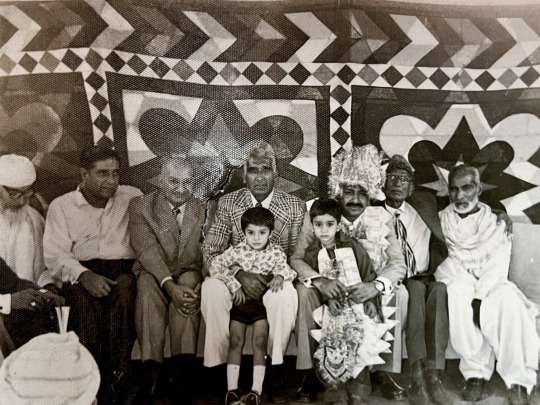
Image 1: My maternal family at a wedding Dawat in post-partition Lahore, Pakistan (1977) The groom, who happens to be my Mamoo (maternal uncle) is adorned with shiny headwear and garlands sewn with cash notes. The colourful, patterned shamiana tent veiling the Dawat is a common occurrence in banquet halls even today. Dawats also serve as the ideal opportunity to get multiple family members and kin together for a group portrait, a crucial and vital method of documenting a visual record of humans that are often overlooked and erased from history and whose lived experiences have been minimized and rendered invisible by colonial hegemonies.
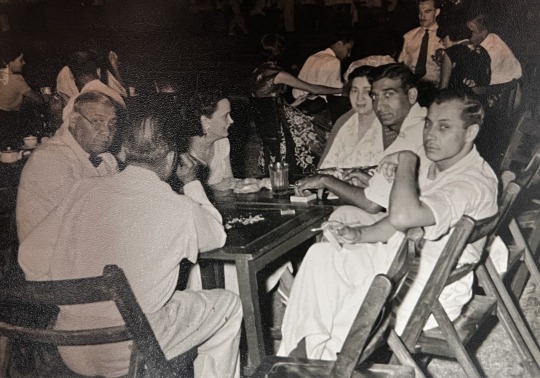
Image 2: My maternal grandfather, F.D Chaudhry, a soldier in the British Army, hosting his British and German friends at a small Dawat in post-partition Lahore, Pakistan (1950) These are foreign families that chose to remain in Pakistan after the partition of the country from India, but have since returned to their respective homelands.

Image 3: My mother, Mohtarma Rubina Magsi, celebrating Shab-e-Barat, a major Dawat for the global Muslim community, honoured in the month of Sha'ban in the Islamic calendar (1980s) After finishing our prayers in new clothes, we would head outside into the garden to play with sparklers and light little diyas (oil lamps made from clay) all around the boundary walls of our home. The deceased are honoured on this day and the festival is celebrated in unique ways in Muslim countries around the world, depending on the country and culture.
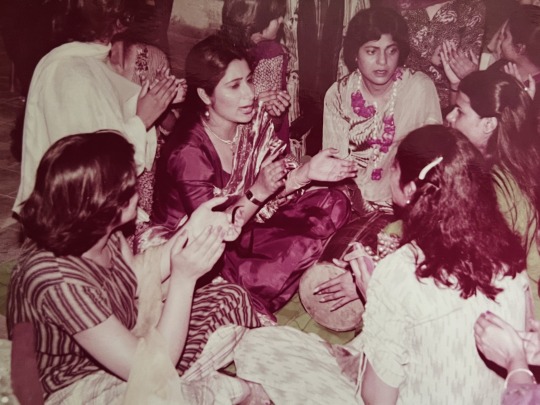
Image 4: Mohtarma Rubina Magsi surrounded by her singing and clapping women friends ( Late 1970s) They are taking turns playing the dhol (drum). Often a sturdy, silver spoon is also hit onto the center of the dhol to add depth to the music. Some guests may even reach for a dufflee (tambourine) and clap it against their henna stained palms. The music can range from orally transmitted folk songs to Bollywood hits from across the border. Healthy competition is fostered as guests attempt to outdo one another with an impressively long array of memorized songs.
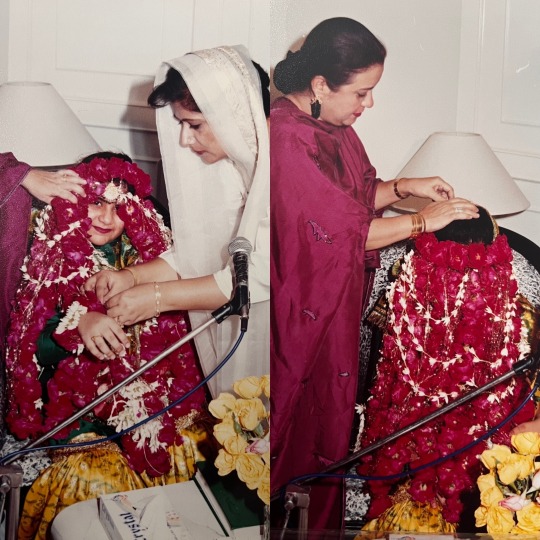
Image 5: A duo collage of community elders veiling my hair and face with heavy garlands of vibrant, red rose flowers to mark the Rasm-e-Ameen, a Dawat hosted to honour the completion of formal Quranic education. The customary prayers are followed by a large buffet style banquet feast. (1993)
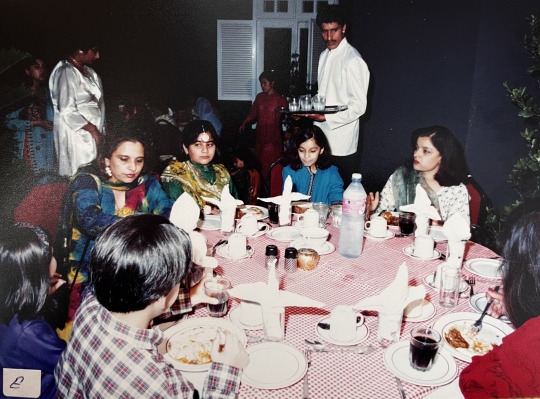
Image 6: Guests enjoying their banquet dinner on a round table after the Rasm-e-Ameen. A waiter holding a tray with glasses watches over the banquet tables to ensure the guests are looked after. (1993)
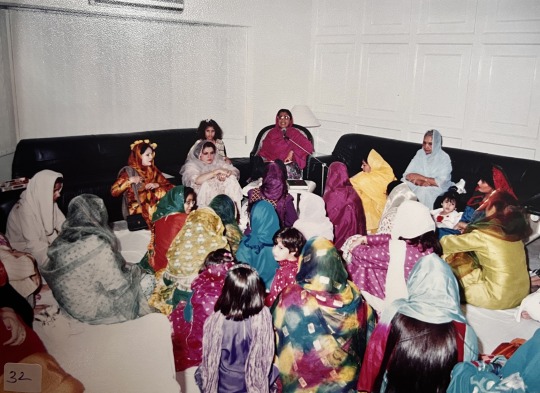
Image 7: A women prioritized Dawat-e-Milad in praise of Prophet Muhammad, hosted at our home in Karachi, Pakistan. Though veiling of the hair is not an imposition in Pakistan, even at women prioritized religious, cultural and spiritual events such as these, both Muslims and non-Muslims loosely cover their hair momentarily, out of respect. (1995)
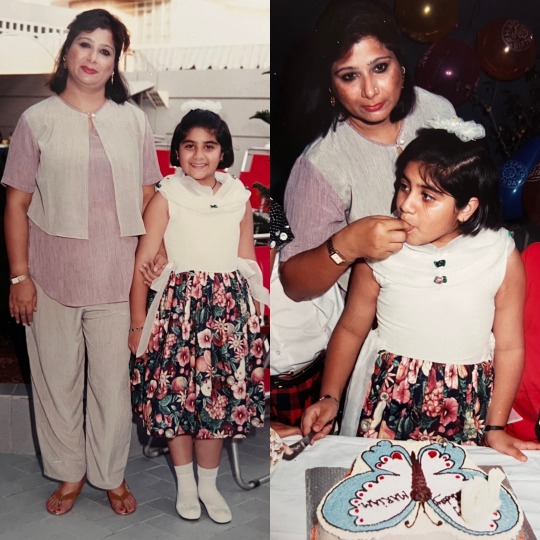
Image 8: A birthday banquet to honour the day I was born. It is interesting to note, that while traditional, cultural garments are prioritized for certain events, like the Dawat-e-Milad, Rasm-e-Ameen or a wedding Dawat, western clothing, games and food is often engaged at Dawats such as birthdays and graduations. (1994)
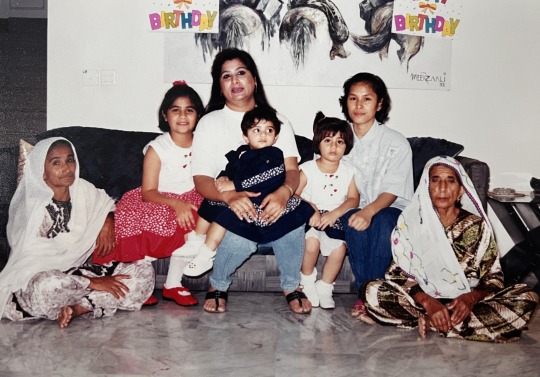
Image 9: Generation after generation, the visibility of women in documentations of family life has increased. This is a family photograph taken on my birthday Dawat (1993) with my mother at the center, surrounded by children, and caregivers from the Philippines and our ancestral lands, Jhal Magsi, Balochistan. I was truly raised by a multi-generational, diverse village of people from all corners of the world. While some members of our family are wearing western clothing, others are dressed in traditional, cultural garments and have chosen to veil their hair.
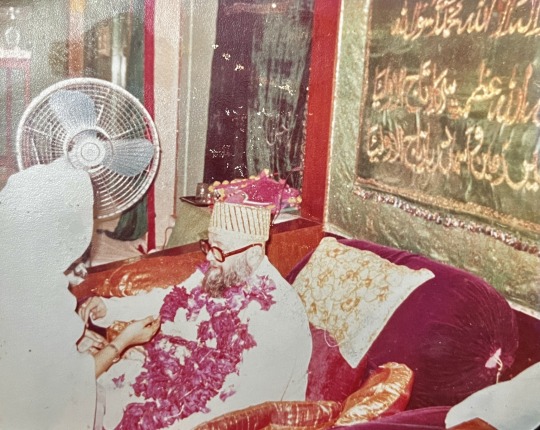
Image 9: A spiritual, Sufi Dawat at the Taji Shrine in Meva Shah, Karachi. My mother is adorning our family's Sufi saint (Baba Anwar Shah Taji) with heavy garlands of red roses. (1980) While flowers are given feminine traits in various cultures around the world, in many South and Central Asian countries, such as India, Pakistan and Nepal, flowers are a gender neutral way of showing love and adoration through the art of ornamentation. After the customary Sufi rituals are complete, the congregation gathers side by side on the floor to consumer Langar, a meal that is served to everyone in attendance, at no cost. The Langar menu can vary from week to week, consisting of curries, rice dishes, naans and sweets, and no one is turned away from the doors of the shrines when Langar is served. Whether cis or trans, male or female, able or disabled, rich or poor, local or foreign, everyone is welcome here. In some shrines the genders are segregated.
Most Dawats in Pakistan mark important life milestones, like births, birthdays, weddings, graduations and are also influenced by cultural traditions and religious rituals, varying from household to household, depending on cast, clan, socioeconomic standing, province and religion.
There are some motifs and symbols that make a recurring appearance, era after era, such as rose petals and night blooming jasmine flowers, shamiana tents, cauldrons of Biryani, unisex garlands and head coverings made with either cash or flowers (or both), various forms of veiling (with both textiles and flowers), the dhol (drum) and of course, endless cups of Chai. Of the various significant Dawats that take place throughout the year, apart from events like birthdays and weddings, certain religious Dawats like Shab-e-Baraat (a major festival for Muslims celebrated in the month of Sha'ban, the eighth month of the Islamic calendar) Rasm-e-Ameen (formal completion of Quranic education), Urs (death anniversaries of Saints and Mystics), Milad (events fostered in praise of Prophet Muhammad) and Niyaz (Meditative chanting and prayers followed by distribution of food amongst the needy) also encompass specific rituals and customs. As visible in the archives, there was also a healthy mix of retaining local, familial customs and traditions, while also engaging with clothing, games, food and rituals from cultures outside of Pakistan.
For example, every New Year’s Eve, it was customary in our home to consume a large feast of purely Filipino food, made by our caregiver, Flordeliza Sauza. Right as the clock would strike midnight, you best believe, we would be shoving Siopao, Pansit and Chicken Adobo with garlic rice into our excited, hungry mouths. Similarly, Chinese food was also a staple, especially at birthday parties and weddings. My wedding Dawat feast in Karachi included several desi Kababs, Curries and Puloas originally devised in the royal kitchens of India, but many Chinese dishes were also served, such as Chicken Manchurian, Beef Chilli, Shrimp Dumplings and Vegetable Fried Rice. This is reflective of a society that is open to global influences.
Women have been at the forefront of cultural continuity in Pakistan, as well as in the diaspora. Religiously inclined Dawats, such as the Milad and the Rasm-e-Ameen often take place in women prioritized spaces, with multi-generational guests in attendance, fostering community and togetherness. One of my favourite moments from the Milad Dawat has to do with guests being showered with delicate, soft sprinkles of rose water, while standing side by side, singing and praying in a unique moment of women's solidarity. In some Milad Dawats, guests are not only showered with droplets of Rose Water, they are also covered with petals from red roses, making the experience truly immersive and embodied.
2 notes
·
View notes
Text
Set of 3 Coins from Pakistan: 1, 2, 5 Rupees. 1998-2006
Price: (as of – Details) 3 CIRCULATED COINS FROM THE ISLAMIC REPUBLIC OF PAKISTAN. Old collectible coins were picked from the numismatic period: Rupee (1998-2006). Each bag may have different years. You will receive a full set of Pakistani coins: 1, 2, 5 Rupees. Pictures on the coins: the Shrine of Lal Shabaz Qalandar, Badshahi Mosque. A portrait of Muhammad Ali Jinnah (a barrister, politician…

View On WordPress
0 notes
Text
#Data Darbar Lahore#Hazrat Ali Hujwiri#Sufi Shrines in Pakistan#Islamic Heritage Sites#Holy Places in Lahore#Hazrat Data Ganj Bakhsh#Sufi Saint Memorials#Religious Tourism in Pakistan#Islamic Spirituality#Historical Sites in Lahore#Pilgrimage Sites in Pakistan#Cultural Heritage of Lahore#Sufism in Pakistan#Islamic History and Culture#Data Darbar Urs Festival
0 notes
Text

2 notes
·
View notes
Text
Data Ali Hujwiri: The Legacy of Data Sahib and His Urs Celebration

Data Ali Hujwiri, renowned as Data Sahib, is a celebrated 11th-century Sufi saint whose legacy endures through his shrine in Lahore. Born in 1009 CE, Data Sahib, whose real name was Abdul Hasan Ali, is honored posthumously as Data Ganj Bakhsh (R.A.). His contributions to Sufism and Islamic teachings have left a lasting impact, making his Urs, or death anniversary, a significant annual event in Lahore. This article provides an overview of the Urs celebration for 2024, the historical background of Data Sahib, and the traditions associated with the event.
Historical Background
Data Ali Hujwiri, also known as Data Sahib, was born in Ghazni, Afghanistan, in 1009 CE. His life was marked by a deep commitment to spreading the teachings of Islam. He migrated to Lahore, where he continued his mission, gaining widespread respect and reverence. Data Sahib's teachings emphasized spiritual growth and devotion, which endeared him to many followers. He passed away in Lahore, where his shrine stands as a testament to his enduring legacy.
The Urs Celebration
The Urs of Data Ganj Bakhsh, also known as Data Sahib, is observed annually from the 18th to the 20th of Safar in the Islamic calendar. This year, the Urs is set to take place from August 25 to August 27, 2024. The dates for the Urs are determined based on the lunar Islamic calendar, specifically the month of Safar. This period marks the death anniversary of Data Sahib, and it is observed with great reverence and celebration at his shrine in Lahore.
Urs Dates for 2024
The Urs for 2024 will be held from the 18th to the 20th of Safar. This three-day event typically falls from Thursday to Saturday, allowing devotees ample time to participate in the celebrations. The observance of these dates is an annual tradition, and although the exact dates can vary with the lunar calendar, the essence of the celebration remains constant.
Celebratory Traditions
During the Urs, the shrine of Data Sahib in Lahore is transformed into a vibrant and festive space. The area is adorned with colorful lights, flowers, and decorations, creating a festive atmosphere. Devotees from across Pakistan and beyond gather to pay their respects, offer prayers, and participate in various religious and cultural activities.
Special prayers, recitations, and sermons are held throughout the event. The festivities often include processions, communal meals, and musical performances that reflect the cultural richness of the region. The entire occasion is a blend of spiritual reverence and cultural celebration, reflecting the deep respect people have for Data Sahib.
Significance and Legacy
Data Sahib's Urs is not just a commemoration of his death but a celebration of his life and teachings. His contributions to Sufism and Islamic thought continue to inspire countless individuals. The annual Urs serves as a reminder of his spiritual legacy and the enduring influence of his teachings. It provides an opportunity for followers to reflect on his life, seek blessings, and renew their commitment to spiritual growth.
Visitor Information
For those planning to visit Lahore during the Urs, it is advisable to make arrangements well in advance. The shrine attracts a large number of visitors, and accommodations and travel plans should be made early to ensure a smooth experience. The vibrant atmosphere and the spiritual ambiance make the Urs a memorable event for all who attend.
The Urs of Data Ali Hujwiri, or Data Sahib, is a significant event in Lahore's cultural and spiritual calendar. Observed annually from the 18th to the 20th of Safar, this celebration honors the life and teachings of one of Sufism's most revered saints. As 2024 approaches, the dates for the Urs are set for August 25 to August 27, offering an opportunity for devotees and visitors to participate in this deeply meaningful and vibrant event. Data Sahib's legacy continues to shine brightly, and his Urs remains a testament to his enduring influence on the spiritual landscape.
1 note
·
View note
Text
Exploring the Spiritual Sanctuary of Bari Imam in Islamabad
Nestled in the serene Margalla Hills of Islamabad, Bari Imam is a spiritual and historical landmark that attracts thousands of devotees and tourists alike. Join us at The Travel Tute as we delve into the rich history, cultural significance, and tranquil beauty of Bari Imam, a must-visit destination in Pakistan’s capital city.

Introduction to Bari Imam
Welcome to Bari Imam, a revered shrine dedicated to the famous Sufi saint Hazrat Shah Abdul Latif Kazmi, commonly known as Bari Imam. Located near the village of Nurpur Shahan in Islamabad, this spiritual sanctuary offers a peaceful retreat and a glimpse into the profound Sufi traditions of Pakistan. The Travel Tute is here to guide you through the enchanting experience that awaits at Bari Imam.
Historical Significance

Bari Imam was established in honor of Hazrat Bari Imam, a 17th-century Sufi saint renowned for his piety, wisdom, and miracles. Born in 1617 in Punjab, Bari Imam dedicated his life to spreading the teachings of Islam and Sufism. The shrine was built by the Mughal Emperor Aurangzeb, reflecting its historical and architectural importance. Today, it stands as a symbol of spiritual devotion and cultural heritage.
Architectural Marvel
The shrine of Bari Imam is an architectural gem, showcasing intricate Mughal and Islamic design elements. The beautifully decorated interior features ornate tile work, calligraphy, and stunning chandeliers, creating an atmosphere of reverence and awe. The serene courtyard, adorned with lush greenery and fountains, provides a tranquil space for meditation and reflection.
Spiritual Experience

Visiting Bari Imam offers a unique spiritual experience. Devotees and visitors often participate in rituals, prayers, and recitations of Sufi poetry, seeking blessings and solace. The shrine is particularly vibrant during the annual Urs festival, which commemorates the death anniversary of Bari Imam. During this time, the shrine is illuminated with lights, and devotees gather for qawwali (Sufi devotional music), dhikr (remembrance of God), and other spiritual activities.
Cultural Heritage
Bari Imam is not just a religious site; it is a cultural hub that reflects the rich heritage of Sufism in Pakistan. The shrine attracts people from diverse backgrounds, fostering a sense of unity and brotherhood. Visitors can explore the surrounding bazaar, which offers traditional handicrafts, local cuisine, and souvenirs, providing an immersive cultural experience.
Scenic Beauty

Set against the backdrop of the Margalla Hills, Bari Imam offers breathtaking natural beauty. The serene environment, with its lush greenery and scenic views, enhances the spiritual ambiance of the shrine. Visitors can also explore nearby hiking trails and picnic spots, making it a perfect destination for nature lovers and those seeking a peaceful escape from the bustling city.
Accessibility and Facilities
Bari Imam is easily accessible from various parts of Islamabad. The shrine is well-maintained, offering facilities such as parking, restrooms, and food stalls. Guided tours are available for those interested in learning more about the history and significance of the shrine. The friendly and welcoming atmosphere ensures a comfortable visit for all.
Best Time to Visit
While Bari Imam is open to visitors year-round, the best time to visit is during the cooler months from October to March. The annual Urs festival, held in the Islamic month of Safar, is a particularly special time to experience the shrine's vibrant cultural and spiritual activities.
Conclusion
Discover the spiritual and cultural richness of Bari Imam in Islamabad with The Travel Tute as your guide. Whether you seek spiritual solace, historical insight, or simply a tranquil retreat, Bari Imam offers an enriching experience that will leave you inspired and rejuvenated. Plan your visit today and explore the serene beauty and profound heritage of this iconic shrine in the heart of Pakistan's capital.
0 notes
Text
In Pictures: Eid Celebrations Around The World
Muslims around the world have begun celebrating Eid al-Fitr, one of the biggest celebrations in the Islamic calendar. Eid al-Fitr - which means "festival of the breaking of the fast" - is celebrated at the end of Ramadan, a month of fasting for many adults, as well as spiritual reflection and prayer.

Crowds gathered outside a mosque in Palembang, Indonesia
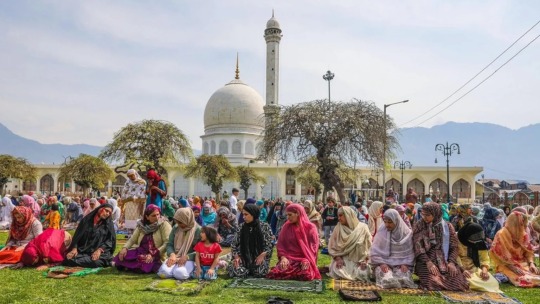
Women pray near a Muslim shrine in Srinagar in Indian-Occupied Kashmir.

A boy stands in the middle of a crowd of people praying in Nairobi, Kenya.
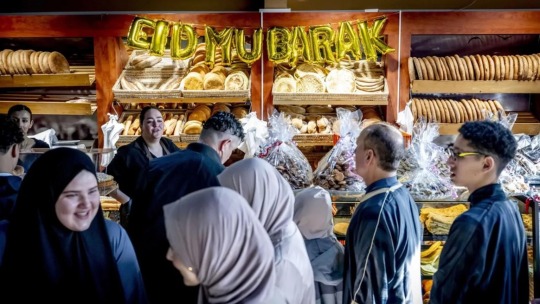
In Rotterdam, the Netherlands, people buy sweets in a bakery as part of the celebrations.
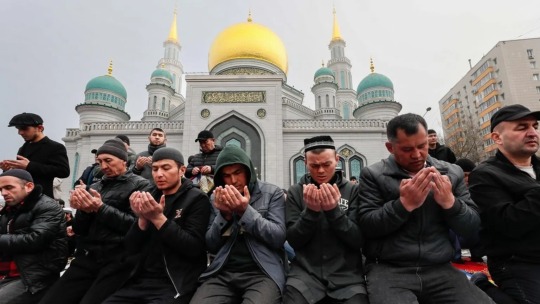
In the Russian capital, Moscow, worshippers pray outside the Central Sobornaya Mosque.

Here, thousands are celebrating on the eve of the Eid al-Fitr on a street in Jakarta, Indonesia.
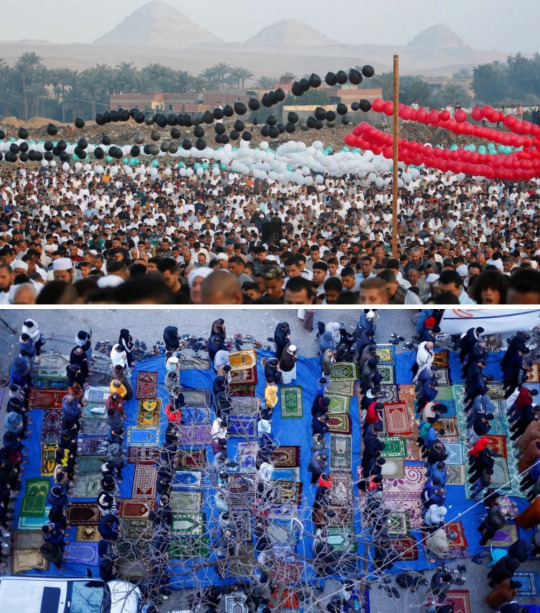
Top: In Egypt, people gathered under balloons in the colours of the Palestinian flag in a show of support for fellow Muslims caught in the Gaza war.
Bottom: In Gaza itself, Palestinians gathered for prayers in the southern town of Rafah which “Terrorist, Fascist, Apartheid, War Criminal, Zionist 🐖 Illegal Regime of Isra-hell” has promised to attack as part of its stated aim of eliminating Hamas.

Top: At al-Aqsa mosque in Jerusalem - the third holiest site in Islam - worshippers took pictures.
Bottom: Women take cover under an umbrella in Manila, the Philippines.

Top: A man sells balloons during celebrations in Karachi, Pakistan.
Bottom: A family take a selfie in Cambridge, UK.
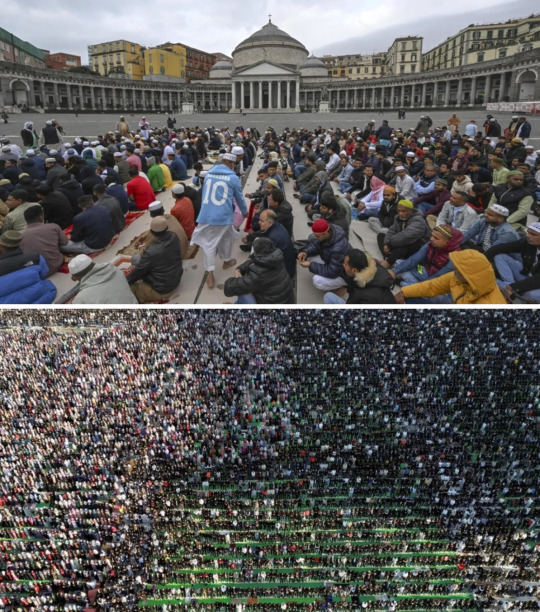
Top: Worshippers gathered in Naples, Italy.
Bottom: Thousands knelt in prayer in Skanderbeg Square in Tirana, Albania.
#Eid-ul-Fitr#Islam ☪️#Religion#Miscellaneous Photographs#Eid Celebrations#Around the Globe 🌎#Muslims#Muslim Ummah#End of Ramadan#Spirtual Reflection#Prayers#BBC
0 notes
Text
Things to Do in Afghanistan - Attractions & Tourist Spots

Certainly, Afghan Tours offers various attractions and tourist spots that showcase its rich cultural heritage, stunning landscapes, and historical significance. Here are some notable things to do and places to visit in Afghanistan:
Kabul: Explore the capital city, Kabul, and visit attractions such as the Kabul Museum, Kabul Zoo, and the historic Babur Gardens.
Herat: Discover the ancient city of Herat, known for its beautiful mosques, historical sites like the Herat Citadel, and vibrant bazaars.
Mazar-i-Sharif: Visit the Blue Mosque, also known as the Shrine of Hazrat Ali, one of the holiest sites in Afghanistan.
Bamiyan Valley: Explore the UNESCO World Heritage Site of Bamiyan Valley, known for the giant Buddha statues (destroyed in 2001) and its stunning natural beauty.
Band-e Amir National Park: Enjoy the breathtaking beauty of Afghanistan's first national park, known for its stunning blue lakes and limestone formations.
Panjshir Valley: Experience the scenic beauty of the Panjshir Valley, famous for its emerald-green landscapes, mountains, and historical significance.
Khyber Pass: Visit the historic Khyber Pass, a mountain pass connecting Afghanistan with Pakistan, known for its strategic importance and ancient history.
Minaret of Jam: Explore the Minaret of Jam, a UNESCO World Heritage Site and one of the tallest brick minarets in the world, located in a remote valley in western Afghanistan.
Gardens of Babur: Relax in the historic Gardens of Babur in Kabul, which were laid out by the Mughal emperor Babur in the 16th century and offer beautiful views of the city.
National Museum of Afghanistan: Learn about Afghanistan's rich history and culture by visiting the National Museum of Afghanistan in Kabul, which houses a vast collection of artifacts dating back to ancient times.
Darul Aman Palace: Explore the ruins of Darul Aman Palace, a symbol of Afghanistan's turbulent history, located on the outskirts of Kabul.
Chakhcharan: Visit the town of Chakhcharan in Ghor Province, known for its scenic beauty, historic sites, and traditional Afghan culture.
Ghazni: Explore the city of Ghazni, which was once an important center of Islamic culture and is home to historical sites such as the Ghazni Minarets and the Citadel of Ghazni.
Safi Landmark Hotel Rooftop: Enjoy panoramic views of Kabul from the rooftop of Safi Landmark Hotel, offering a unique perspective of the city.
Food and Culture: Experience Afghan cuisine and culture by sampling delicious dishes like kebabs, qabuli pulao, mantu, and Afghan tea while interacting with friendly locals.
1 note
·
View note